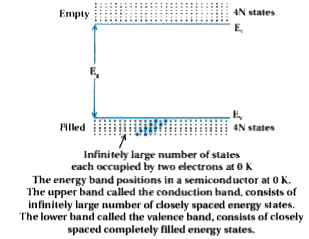Explain by drawing the energy levels of Si and Ge containing N atoms at 0 K temperature. Solution in Gujrati
Atomic number of Si is 14. The electron configuration of silicon atom is 1s22s22p63s23p2 hence K and L shells are completely filled and M shell is incomplete and there are 3s23p2 valence electron in it.
And atomic number of Ge is 32. The electron configuration of silicon atom is 1s22s22p63s23p63d104s24p2 hence K, L and M shells are completely filled and N shell is incomplete and there are 4s24p2 valence electron in it.
Hence both Si and Ge semiconductor are tetravalent.
There are total 4 electrons in outermost orbit of Si or Ge crystal. The maximum possible number of electron in the outer orbit is 8(2s+6p electrons).
So, for the 4N valence electrons there are 8N energy states.
These 8N discrete energy levels can either form a continuous band or they may be grouped in different bands depending upon the distance between the atoms in the crystal.
At the distance between the atoms in the crystal lattices of Si and Ge, the energy band of these 8N states is split apart into two which are separated by an energy gap Eg, which is shown in the figure below.

The energy band positions in a semiconductor at 0 K.
The upper band called the conduction band, consists of infinitely large number of closely spaced energy states.
The lower band called the valence band, consists of closely spaced completely filled energy states.
The lower band which is completely occupied by the 4N valence electrons at temperature of absolute zero is the valence band and there is an upper conduction ban with 4N energy levels, which is completely empty at absolute zero temperature.
The lowest energy level in the conduction band is shown as Ec and highest energy level in the valence band is shown as Ev. Above Ec and below Ev there are a large number of closely spaced energy levels as shown in figure.
The gap between the top of the valence band and bottom of the conduction band is called the energy band gap (Energy gap Eg). It is known as forbidden gap.
Topper's Solved these Questions
- SEMICONDUCTOR ELECTRONICS : MATERIALS, DEVICES AND SIMPLE CIRCUITS BOOK - KUMAR PRAKASHANCHAPTER - SEMICONDUCTOR ELECTRONICS : MATERIALS, DEVICES AND SIMPLE CIRCUITS EXERCISE - Section-B : Numericals (Numerical From Textual illustrations)
16 Videos
- SEMICONDUCTOR ELECTRONICS : MATERIALS, DEVICES AND SIMPLE CIRCUITS BOOK - KUMAR PRAKASHANCHAPTER - SEMICONDUCTOR ELECTRONICS : MATERIALS, DEVICES AND SIMPLE CIRCUITS EXERCISE - Section-B : Numericals (Numerical From Textual Exercise)
15 Videos
- SEMICONDUCTOR ELECTRONICS : MATERIALS, DEVICES AND SIMPLE CIRCUITS BOOK - KUMAR PRAKASHANCHAPTER - SEMICONDUCTOR ELECTRONICS : MATERIALS, DEVICES AND SIMPLE CIRCUITS EXERCISE - Section-D : Multiple Choice Questions (MCQs) (MCQs asked in Competitive Exams)
129 Videos
- SAMPLE QUESTION PAPER BOOK - KUMAR PRAKASHANCHAPTER - SAMPLE QUESTION PAPER EXERCISE - PART-B SECTION-C
5 Videos
- WAVE OPTICSBOOK - KUMAR PRAKASHANCHAPTER - WAVE OPTICSEXERCISE - SECTION-D (MULTIPLCE CHOICE QUESTIONS (MCQS)) (MCQS FROM DARPAN BASED ON TEXTBOOK)
239 Videos
Similar Questions
C, Si and Ge have same lattice structure. Why is C insulator while Si and Ge intrinsic semiconductors?
View SolutionIn an n type silicon, which of the following statements is true:
View SolutionAt absolute zero temperature Si acts as ……..
View SolutionTwo charges –q and +q are located at points (0, 0, –a) and (0, 0, a), respectively.
(a) What is the electrostatic potential at the points (0, 0, z) and (x, y, 0) ?
(b) Obtain the dependence of potential on the distance r of a point from the origin when r/a>>1 .
(c) How much work is done in moving a small test charge from the point (5,0,0) to (–7,0,0) along the x-axis? Does the answer change if the path of the test charge between the same points is not along the x-axis?
View SolutionAccording to particle theory of light what is the velocity of light in a dense medium, compared to that in rare medium ?
View SolutionThe catenation tendency of C, Si , and Ge is in the order Ge lt Si lt C . The bond energies (in kJ mol^(-1) ) of C-C-, Si-Si , and Ge-Ge bonds, respectively, are
View SolutionH - परमाणु के ऊर्जा -स्तर ( energy levels ) क्वांटीकृत( quantised ) होते हैं । व्याख्या करो ।
View Solutionजब हाइड्रोजन परमाणु के n=4 ऊर्जा स्तर से n=2 ऊर्जा स्तर में इलेक्ट्रॉन होता है तो किस तरंग-दैर्ध्य का प्रकाश उत्सर्जित होगा ?
View Solutionहाइड्रोजन परमाणु का ऊर्जा-स्तर आरेख खींचिए।
View Solutionपरमाणु का ऊर्जा स्तर क्या हैं ? हाइड्रोजन परमाणु के विभिन्न ऊर्जा स्तर की ऊर्जा की गणना कीजिए तथा इसका आरेख बनाइए ।
View SolutionThe catenation tendency of C, Si and Ge is the order GeltSiltC . The bond energies (in Kjmol^(-1) ) of C-C, Si-Si and Ge-Ge bonds, respectively are
View Solutionहाइड्रोजन परमाणु के लिए ऊर्जा-स्तर आरेख खींचकर उसकी निम्नतम अवस्था तथा उत्तेजित अवस्था को समझाइए।
View SolutionThe catenation tendency of C, Si and Ge is in the order Ge<Si<C. The bond energies (in kJ mol−1) of C-C, Si-Si and Ge-Ge bonds, respectively, are
View SolutionDraw energy band diagrams of n-type and p-type semiconductors at temperature T > O K. Mark the donor and acceptor energy levels with their energies.
View SolutionDraw and explain energy level diagram for hydrogen atom showing spectral series emitted by it.
View Solution
